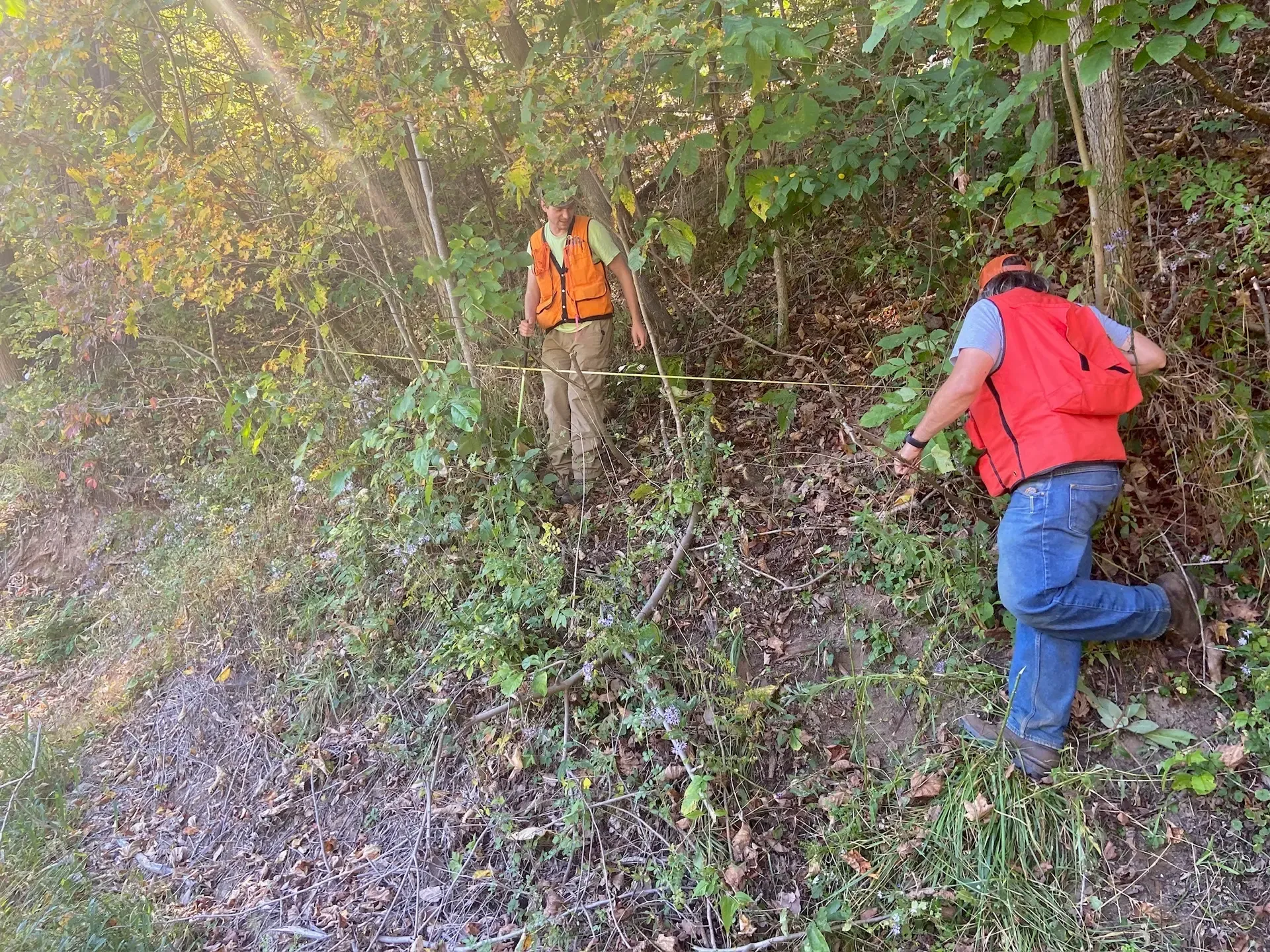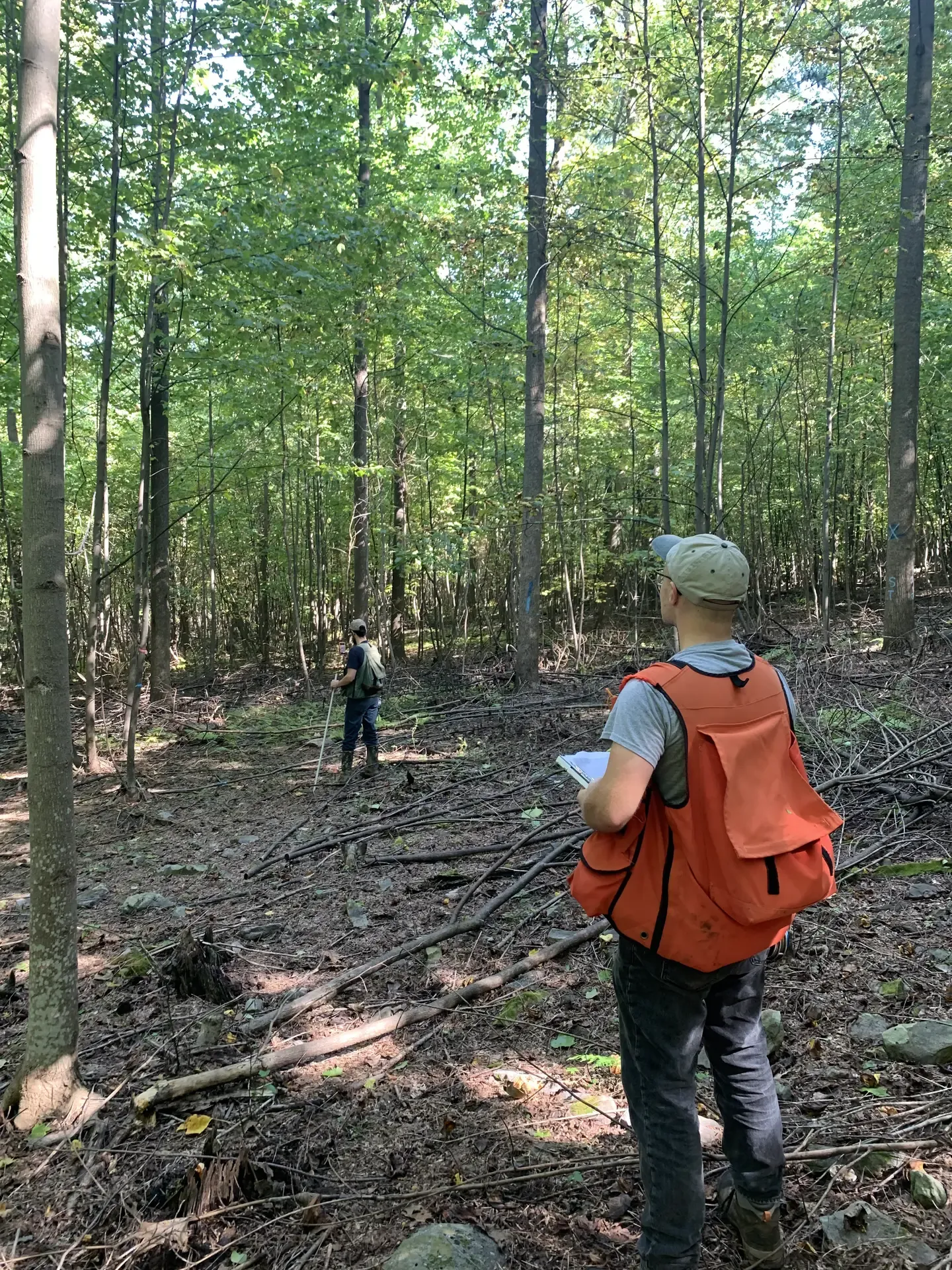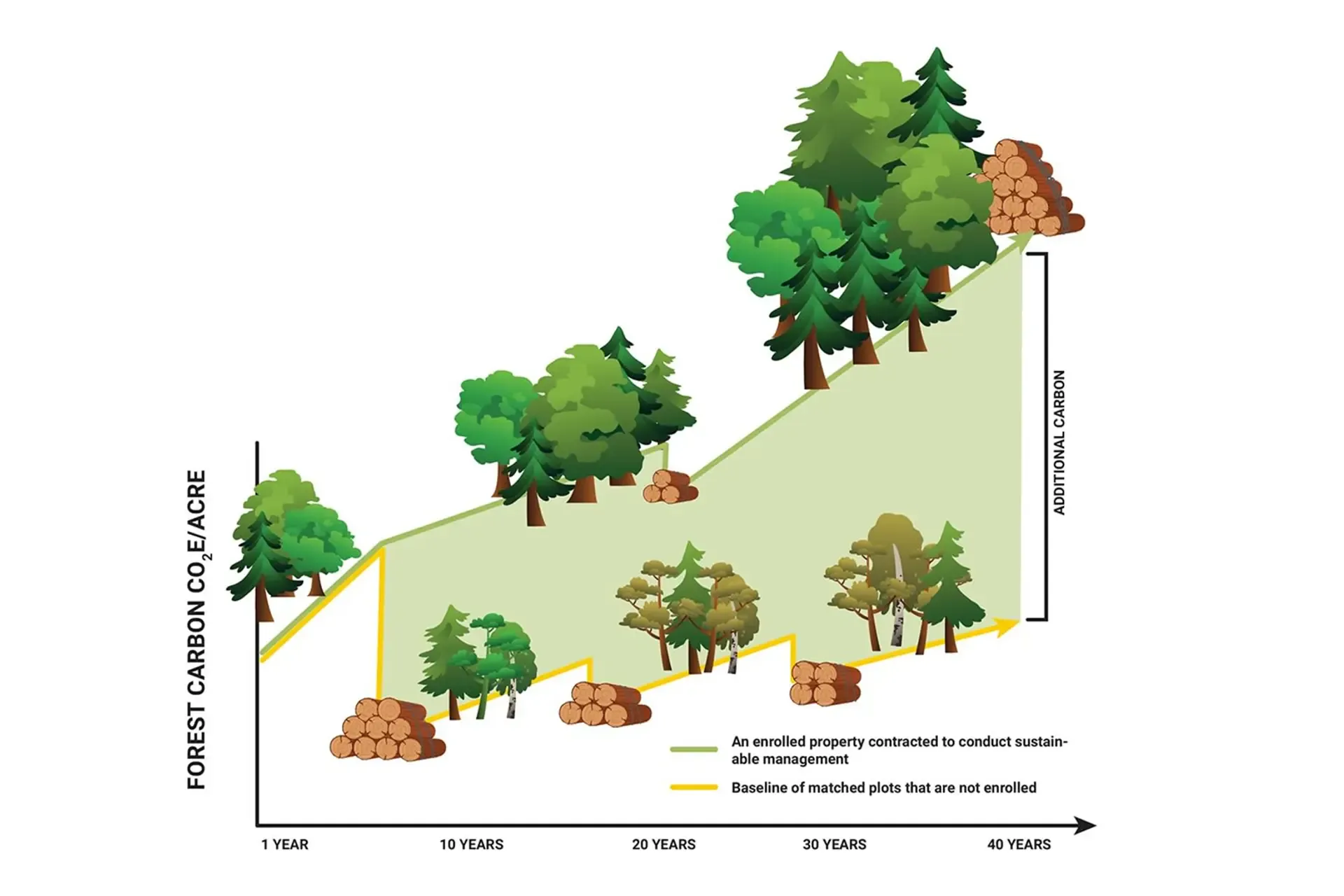Our Methodology in Action

Isaac Slone, AFF's Outreach Forester (right), takes measurements of a tree-line alongside a consulting forester from TerraCarbon.
Forests and their stewards, particularly family forest owners, are a crucial piece to solving the climate crisis puzzle. Since 2020, AFF’s Family Forest Carbon Program has been unlocking access to the voluntary carbon market for family forest owners, equipping them with climate-smart forestry practices that improve the health and wellbeing of their woodlands while also removing more carbon from our warming climate. But to be successful in both of these outcomes, AFF worked with partners to develop a first-of-its-kind carbon accounting methodology that accurately measures our real impact on the planet.
With three years of operation under our belt, we have seen the methodology officially approved by Verra’s Verified Carbon Standard, as well as a broader call for the use of dynamic baseline methodologies across all types of nature-based projects. But with so much skepticism around the effectiveness of natural climate solutions in our fight against climate change, it’s important to understand the nuances in scientific approach that make a lasting impact on our forests, their stewards, and our planet.
What makes FFCP’s methodology unique?
Visit our previous blog for a quick refresh on the basics of our methodology.
The methodology used in the Family Forest Carbon Program was developed by AFF in partnership with TerraCarbon and the Nature Conservancy. There are two major elements to this methodology that provide a more accurate reflection of the real progress made by the project towards reducing carbon emissions. They help to ensure that emissions reductions are genuine and additional to what would have occurred in the absence of the project.
1. Using a matched control group
This concept has long been implemented in the field of public health to design quasi-experimental studies. A matched case-control study is a type of research design typically used to investigate the causes of a specific health outcome or treatment. It is a variation of the traditional case-control study that includes an additional level of control for potential confounding factors through the matching of cases and controls.
In the case of FFCP, the controls are the US Forest Service’s Forest Inventory Analysis (FIA) inventory plots on properties that are not enrolled in FFCP. The matching criteria are predetermined characteristics used to select controls based on their “similarity” to our enrolled project areas. For example, if studying lung cancer in smokers, cases and controls may be matched on age, gender, smoking history, etc. In FFCP, the project cases and the controls are matched by a set of 14 landowner, landscape, and forest characteristics that are then applied to a nearest-neighbor, one-to-many matching protocol, with the use of observational data to identify the best fit matches between our project plots and the FIA control plots.
2. The dynamic baseline
The methodology’s baseline is dynamic because we continuously monitor both the project cases and the controls throughout the life of the project. This comparison measures the carbon sequestered in real time on FFCP-enrolled properties that are implementing improved forest management practices to the baseline of unenrolled control properties over the lifetime of the project, providing more accurate measurements of the additional carbon stored on enrolled properties as a result of our program. Unlike traditional projected baseline methodologies, this observational method improves the accuracy of tracking and reporting the real progress made by the project towards reducing carbon emissions.
To learn more about FFCP's unique methodology, watch "Explained: FFCP's Forest Carbon Methodology."
Our Progress
FFCP is currently undergoing our first round of validation and verification of the credits produced by our program’s intervention, according to the rules and requirements of the Verified Carbon Standard. This first round will verify the amount of additional carbon sequestered on 25,971 acres of enrolled family forests.
We are reporting on two cohorts of landowners, totaling 25,971 acres, which have been estimated to produce Net Emission Reductions of 26,782.0 tCO2e. The validation and verification process is expected to take several months to complete, however we anticipate receiving an issuance of credits in the first half of 2024.
FFCP ensures that any credits generated though the program are real, additional, and conservative, through the measurement of permanent forest inventory plots, which are monitored by professional foresters no less then every five years; and continuous remote sensing tools to confirm that enrolled project areas are implementing the improved forest management practices promoted by FFCP and to monitor for potential loss events across 100% of enrolled acres.
One important lesson learned from the use of this new matching methodology is that traditional monitoring methods alone will not be enough to adequately measure the true impacts of forest carbon offset projects. Wall to wall, high-resolution, remote sensing products and Digital Monitoring Reporting and Verification (DMRV) methods will be necessary to accurately reflect the real-world impacts of nature-based climates solutions in general and forest carbon offset projects in particular.

Nathan Hartley, an outreach forester working with AFF (right), walks a woodland property that is enrolled in the Family Forest Carbon Program. Throughout his walk, he takes measurements of tree growth while determining forest health.
The Importance of Good Science
While the use of this new methodological approach provides improved accuracy in accounting for emissions reductions or removals in forest carbon offset projects, it also acknowledges the reality that nature is extremely difficult to measure. The context in which the Family Forest Carbon Program operates – across rolling landscapes of forestland cared for by American families – experiences constant changes with weather, economies, biodiversity, and other factors. Our methodology accounts for these changes to ensure that emissions reductions are genuinely additional and reflect broader evolving conditions. When used appropriately, matched dynamic baseline methodologies can improve the effectiveness of forest carbon projects and is one more tool we can use in the fight to mitigate the effects climate change.
Related Articles

March 10, 2023
VIDEO: Our Carbon Accounting Methodology Explained
Learn more about the Family Forest Carbon Program's carbon accounting methodology that improves accuracy and transparency — and ensures our program is having a real impact.

June 5, 2023
FEATURE: Keep on Moving – Dynamic Baselines Seen Driving Accuracy in Forest Carbon Accounting
In the context of accusations of widespread over-crediting in the voluntary carbon market (VCM), one emergent accounting approach could tackle some of the challenges with auditing of forestry projects, offering real-time and dynamic monitoring of climate impact via remote sensing technologies.

April 7, 2023
The Sticky Wicket that is Additionality
Carbon is everywhere in your forest—in the trees, in their leaves, in the soil, in the dead woody debris that litters the forest floor, and even in the wood products that are created when your trees are harvested. When landowners hear that there are programs that will pay them for their carbon, some think about that carbon—the carbon that is out there in their woods right now, today. But that’s not exactly what carbon programs are after. Carbon programs are after additional carbon—the carbon that would not have been there without the program’s help.